Organisational Development and Leadership Strategies at Barclays Bank
VerifiedAdded on 2020/12/09
|19
|6003
|484
Report
AI Summary
This report provides an in-depth analysis of organisational development, focusing on the context of Barclays Bank. It explores the critical role of leadership in managing and delivering change, emphasizing the importance of leadership in key banking sector changes such as globalisation, internationalisation, strategic management, and technological innovation. The report delves into leadership strategies and capabilities, including the application of Kotter's 8-step model for change and Yukl's suggestions regarding effective leadership styles. It also discusses the measurement of organisational change delivery and the significance of leadership in strategic organisational change, performance measurement, and the management of Key Performance Indicators (KPIs). The report highlights the impact of various leadership styles, including autocratic, participative, and laissez-faire approaches, on organisational outcomes within the banking sector. It provides an overview of the company background, and concludes by emphasizing the need for flexible leadership to drive financial performance and adaptability within the dynamic business environment.
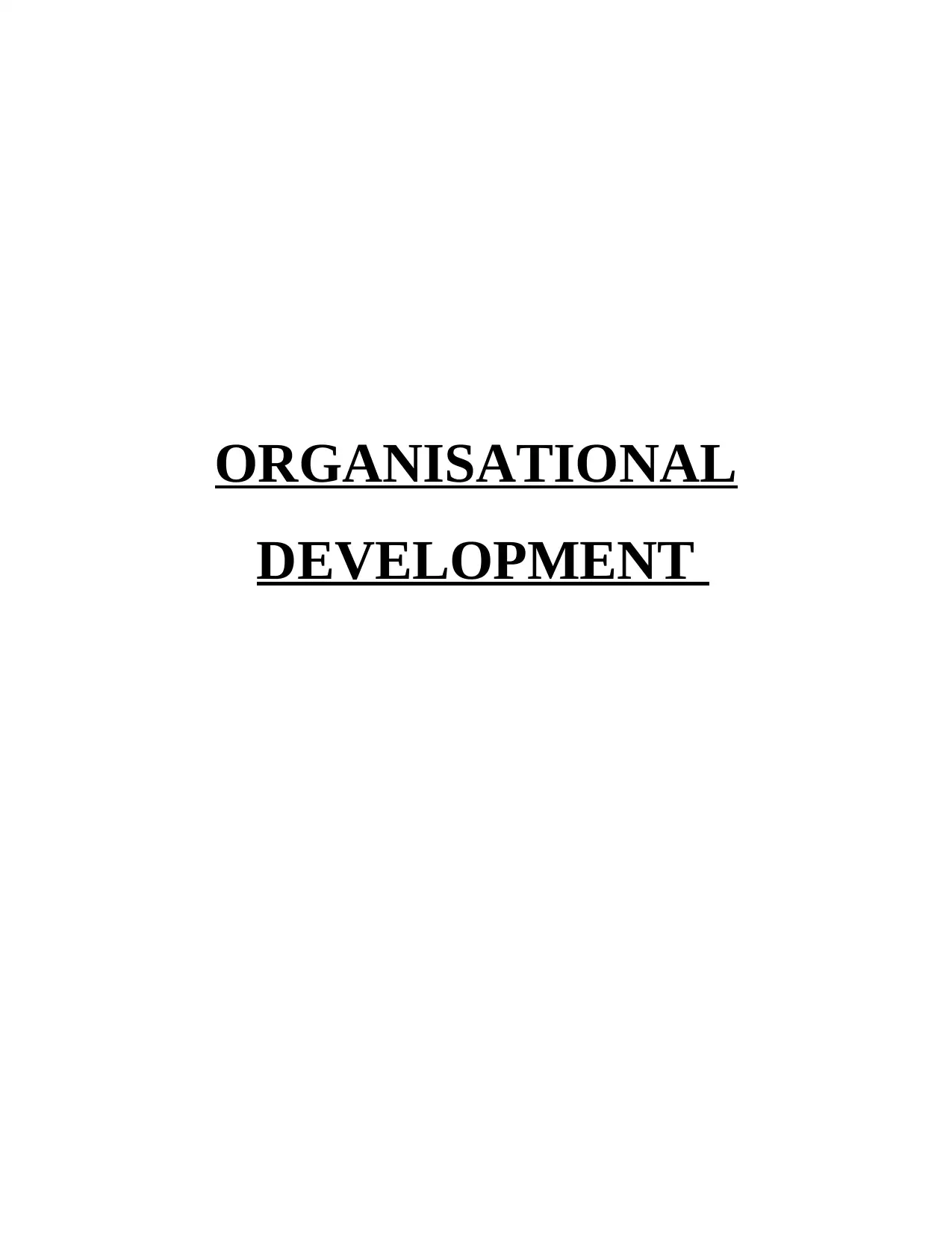
ORGANISATIONAL
DEVELOPMENT
DEVELOPMENT
Paraphrase This Document
Need a fresh take? Get an instant paraphrase of this document with our AI Paraphraser
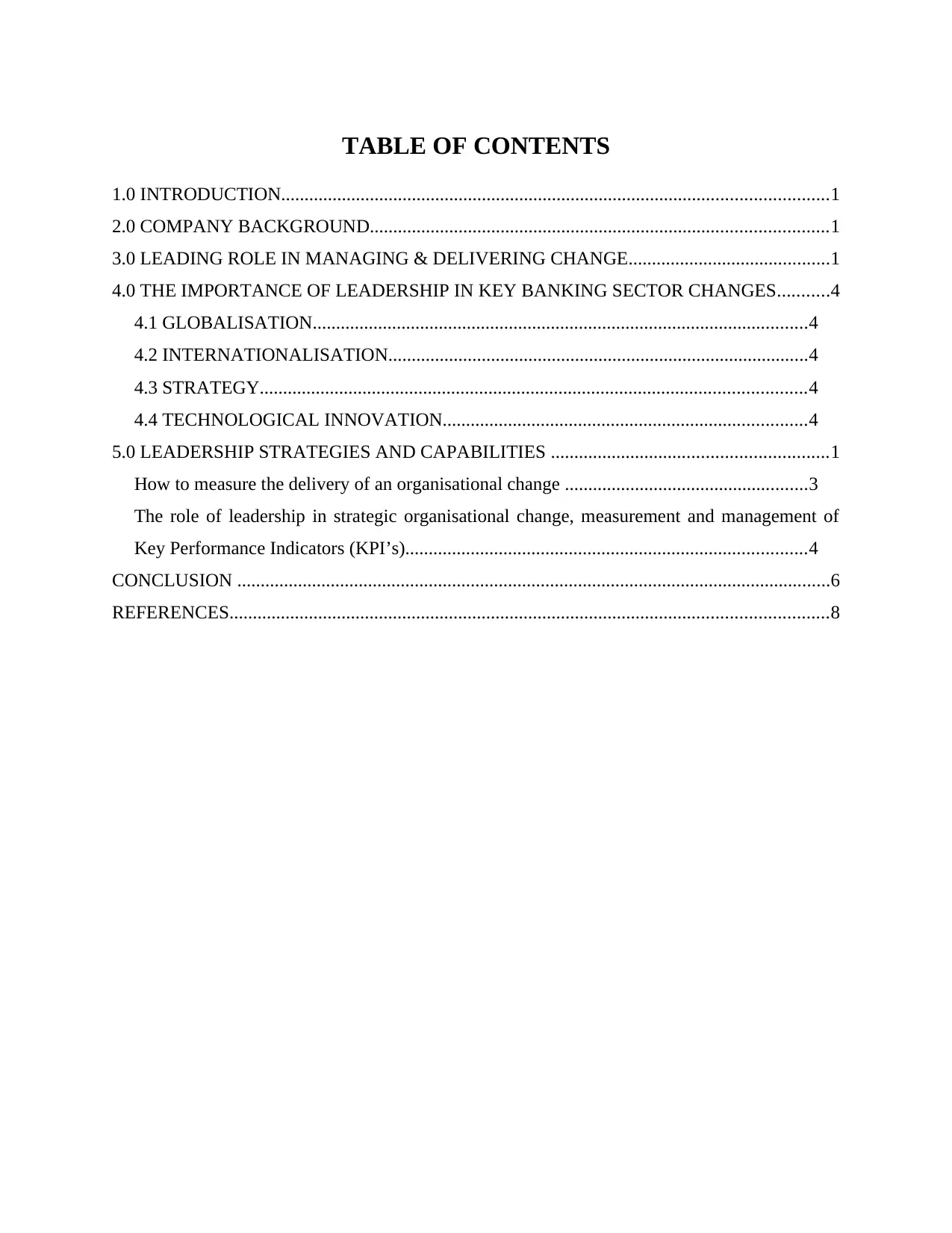
TABLE OF CONTENTS
1.0 INTRODUCTION.....................................................................................................................1
2.0 COMPANY BACKGROUND..................................................................................................1
3.0 LEADING ROLE IN MANAGING & DELIVERING CHANGE...........................................1
4.0 THE IMPORTANCE OF LEADERSHIP IN KEY BANKING SECTOR CHANGES...........4
4.1 GLOBALISATION..........................................................................................................4
4.2 INTERNATIONALISATION..........................................................................................4
4.3 STRATEGY.....................................................................................................................4
4.4 TECHNOLOGICAL INNOVATION..............................................................................4
5.0 LEADERSHIP STRATEGIES AND CAPABILITIES ...........................................................1
How to measure the delivery of an organisational change ....................................................3
The role of leadership in strategic organisational change, measurement and management of
Key Performance Indicators (KPI’s)......................................................................................4
CONCLUSION ...............................................................................................................................6
REFERENCES................................................................................................................................8
1.0 INTRODUCTION.....................................................................................................................1
2.0 COMPANY BACKGROUND..................................................................................................1
3.0 LEADING ROLE IN MANAGING & DELIVERING CHANGE...........................................1
4.0 THE IMPORTANCE OF LEADERSHIP IN KEY BANKING SECTOR CHANGES...........4
4.1 GLOBALISATION..........................................................................................................4
4.2 INTERNATIONALISATION..........................................................................................4
4.3 STRATEGY.....................................................................................................................4
4.4 TECHNOLOGICAL INNOVATION..............................................................................4
5.0 LEADERSHIP STRATEGIES AND CAPABILITIES ...........................................................1
How to measure the delivery of an organisational change ....................................................3
The role of leadership in strategic organisational change, measurement and management of
Key Performance Indicators (KPI’s)......................................................................................4
CONCLUSION ...............................................................................................................................6
REFERENCES................................................................................................................................8
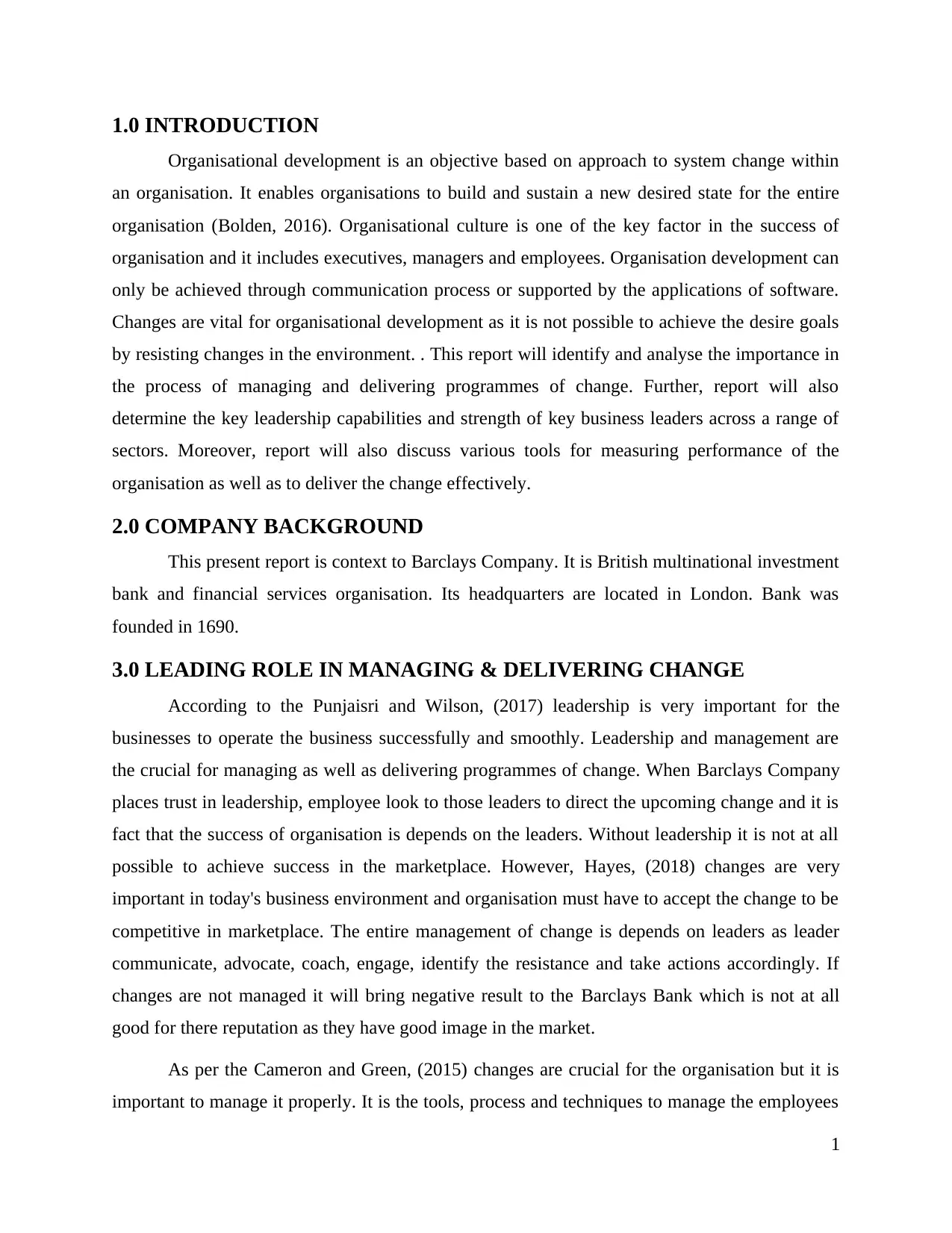
1.0 INTRODUCTION
Organisational development is an objective based on approach to system change within
an organisation. It enables organisations to build and sustain a new desired state for the entire
organisation (Bolden, 2016). Organisational culture is one of the key factor in the success of
organisation and it includes executives, managers and employees. Organisation development can
only be achieved through communication process or supported by the applications of software.
Changes are vital for organisational development as it is not possible to achieve the desire goals
by resisting changes in the environment. . This report will identify and analyse the importance in
the process of managing and delivering programmes of change. Further, report will also
determine the key leadership capabilities and strength of key business leaders across a range of
sectors. Moreover, report will also discuss various tools for measuring performance of the
organisation as well as to deliver the change effectively.
2.0 COMPANY BACKGROUND
This present report is context to Barclays Company. It is British multinational investment
bank and financial services organisation. Its headquarters are located in London. Bank was
founded in 1690.
3.0 LEADING ROLE IN MANAGING & DELIVERING CHANGE
According to the Punjaisri and Wilson, (2017) leadership is very important for the
businesses to operate the business successfully and smoothly. Leadership and management are
the crucial for managing as well as delivering programmes of change. When Barclays Company
places trust in leadership, employee look to those leaders to direct the upcoming change and it is
fact that the success of organisation is depends on the leaders. Without leadership it is not at all
possible to achieve success in the marketplace. However, Hayes, (2018) changes are very
important in today's business environment and organisation must have to accept the change to be
competitive in marketplace. The entire management of change is depends on leaders as leader
communicate, advocate, coach, engage, identify the resistance and take actions accordingly. If
changes are not managed it will bring negative result to the Barclays Bank which is not at all
good for there reputation as they have good image in the market.
As per the Cameron and Green, (2015) changes are crucial for the organisation but it is
important to manage it properly. It is the tools, process and techniques to manage the employees
1
Organisational development is an objective based on approach to system change within
an organisation. It enables organisations to build and sustain a new desired state for the entire
organisation (Bolden, 2016). Organisational culture is one of the key factor in the success of
organisation and it includes executives, managers and employees. Organisation development can
only be achieved through communication process or supported by the applications of software.
Changes are vital for organisational development as it is not possible to achieve the desire goals
by resisting changes in the environment. . This report will identify and analyse the importance in
the process of managing and delivering programmes of change. Further, report will also
determine the key leadership capabilities and strength of key business leaders across a range of
sectors. Moreover, report will also discuss various tools for measuring performance of the
organisation as well as to deliver the change effectively.
2.0 COMPANY BACKGROUND
This present report is context to Barclays Company. It is British multinational investment
bank and financial services organisation. Its headquarters are located in London. Bank was
founded in 1690.
3.0 LEADING ROLE IN MANAGING & DELIVERING CHANGE
According to the Punjaisri and Wilson, (2017) leadership is very important for the
businesses to operate the business successfully and smoothly. Leadership and management are
the crucial for managing as well as delivering programmes of change. When Barclays Company
places trust in leadership, employee look to those leaders to direct the upcoming change and it is
fact that the success of organisation is depends on the leaders. Without leadership it is not at all
possible to achieve success in the marketplace. However, Hayes, (2018) changes are very
important in today's business environment and organisation must have to accept the change to be
competitive in marketplace. The entire management of change is depends on leaders as leader
communicate, advocate, coach, engage, identify the resistance and take actions accordingly. If
changes are not managed it will bring negative result to the Barclays Bank which is not at all
good for there reputation as they have good image in the market.
As per the Cameron and Green, (2015) changes are crucial for the organisation but it is
important to manage it properly. It is the tools, process and techniques to manage the employees
1
⊘ This is a preview!⊘
Do you want full access?
Subscribe today to unlock all pages.

Trusted by 1+ million students worldwide
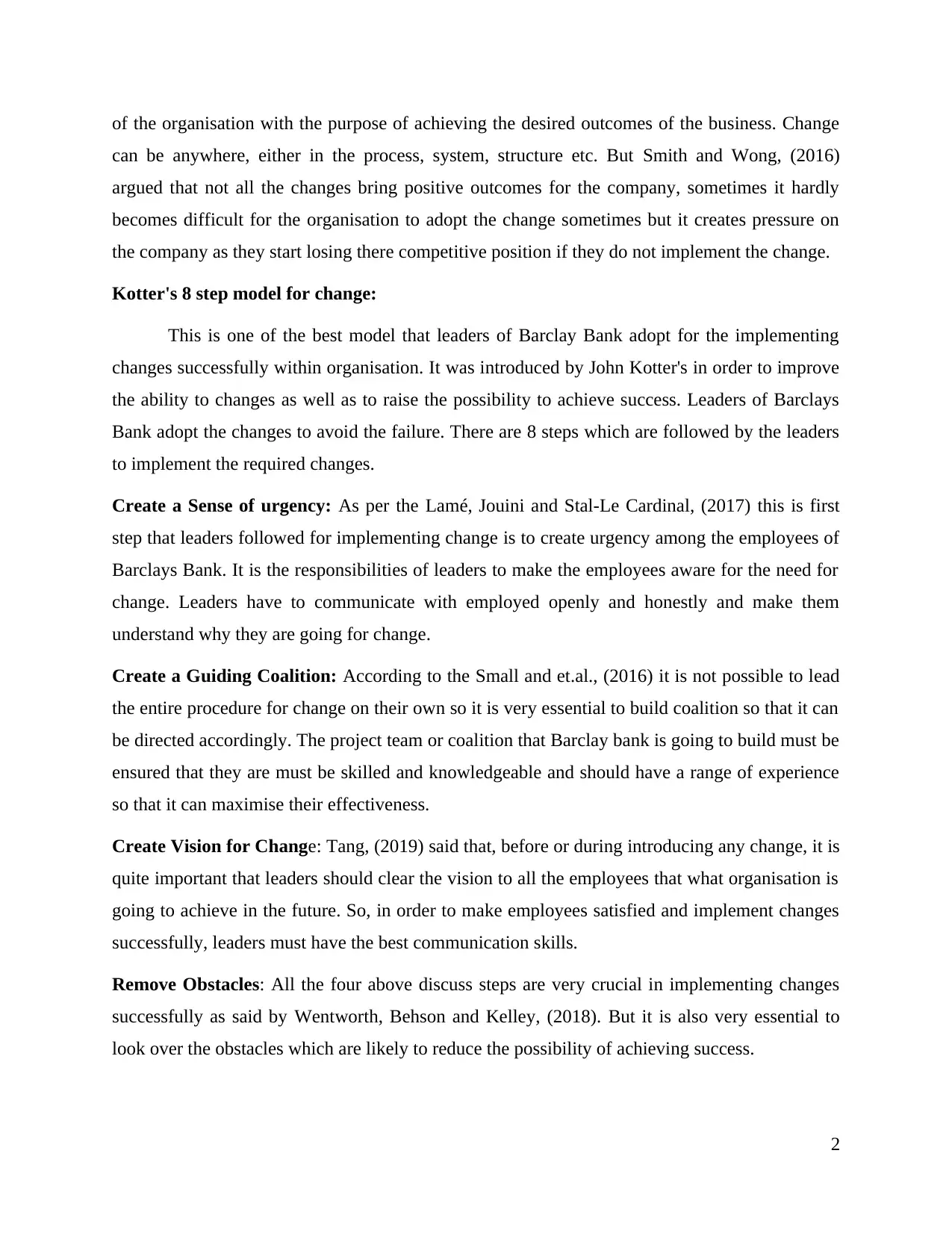
of the organisation with the purpose of achieving the desired outcomes of the business. Change
can be anywhere, either in the process, system, structure etc. But Smith and Wong, (2016)
argued that not all the changes bring positive outcomes for the company, sometimes it hardly
becomes difficult for the organisation to adopt the change sometimes but it creates pressure on
the company as they start losing there competitive position if they do not implement the change.
Kotter's 8 step model for change:
This is one of the best model that leaders of Barclay Bank adopt for the implementing
changes successfully within organisation. It was introduced by John Kotter's in order to improve
the ability to changes as well as to raise the possibility to achieve success. Leaders of Barclays
Bank adopt the changes to avoid the failure. There are 8 steps which are followed by the leaders
to implement the required changes.
Create a Sense of urgency: As per the Lamé, Jouini and Stal-Le Cardinal, (2017) this is first
step that leaders followed for implementing change is to create urgency among the employees of
Barclays Bank. It is the responsibilities of leaders to make the employees aware for the need for
change. Leaders have to communicate with employed openly and honestly and make them
understand why they are going for change.
Create a Guiding Coalition: According to the Small and et.al., (2016) it is not possible to lead
the entire procedure for change on their own so it is very essential to build coalition so that it can
be directed accordingly. The project team or coalition that Barclay bank is going to build must be
ensured that they are must be skilled and knowledgeable and should have a range of experience
so that it can maximise their effectiveness.
Create Vision for Change: Tang, (2019) said that, before or during introducing any change, it is
quite important that leaders should clear the vision to all the employees that what organisation is
going to achieve in the future. So, in order to make employees satisfied and implement changes
successfully, leaders must have the best communication skills.
Remove Obstacles: All the four above discuss steps are very crucial in implementing changes
successfully as said by Wentworth, Behson and Kelley, (2018). But it is also very essential to
look over the obstacles which are likely to reduce the possibility of achieving success.
2
can be anywhere, either in the process, system, structure etc. But Smith and Wong, (2016)
argued that not all the changes bring positive outcomes for the company, sometimes it hardly
becomes difficult for the organisation to adopt the change sometimes but it creates pressure on
the company as they start losing there competitive position if they do not implement the change.
Kotter's 8 step model for change:
This is one of the best model that leaders of Barclay Bank adopt for the implementing
changes successfully within organisation. It was introduced by John Kotter's in order to improve
the ability to changes as well as to raise the possibility to achieve success. Leaders of Barclays
Bank adopt the changes to avoid the failure. There are 8 steps which are followed by the leaders
to implement the required changes.
Create a Sense of urgency: As per the Lamé, Jouini and Stal-Le Cardinal, (2017) this is first
step that leaders followed for implementing change is to create urgency among the employees of
Barclays Bank. It is the responsibilities of leaders to make the employees aware for the need for
change. Leaders have to communicate with employed openly and honestly and make them
understand why they are going for change.
Create a Guiding Coalition: According to the Small and et.al., (2016) it is not possible to lead
the entire procedure for change on their own so it is very essential to build coalition so that it can
be directed accordingly. The project team or coalition that Barclay bank is going to build must be
ensured that they are must be skilled and knowledgeable and should have a range of experience
so that it can maximise their effectiveness.
Create Vision for Change: Tang, (2019) said that, before or during introducing any change, it is
quite important that leaders should clear the vision to all the employees that what organisation is
going to achieve in the future. So, in order to make employees satisfied and implement changes
successfully, leaders must have the best communication skills.
Remove Obstacles: All the four above discuss steps are very crucial in implementing changes
successfully as said by Wentworth, Behson and Kelley, (2018). But it is also very essential to
look over the obstacles which are likely to reduce the possibility of achieving success.
2
Paraphrase This Document
Need a fresh take? Get an instant paraphrase of this document with our AI Paraphraser
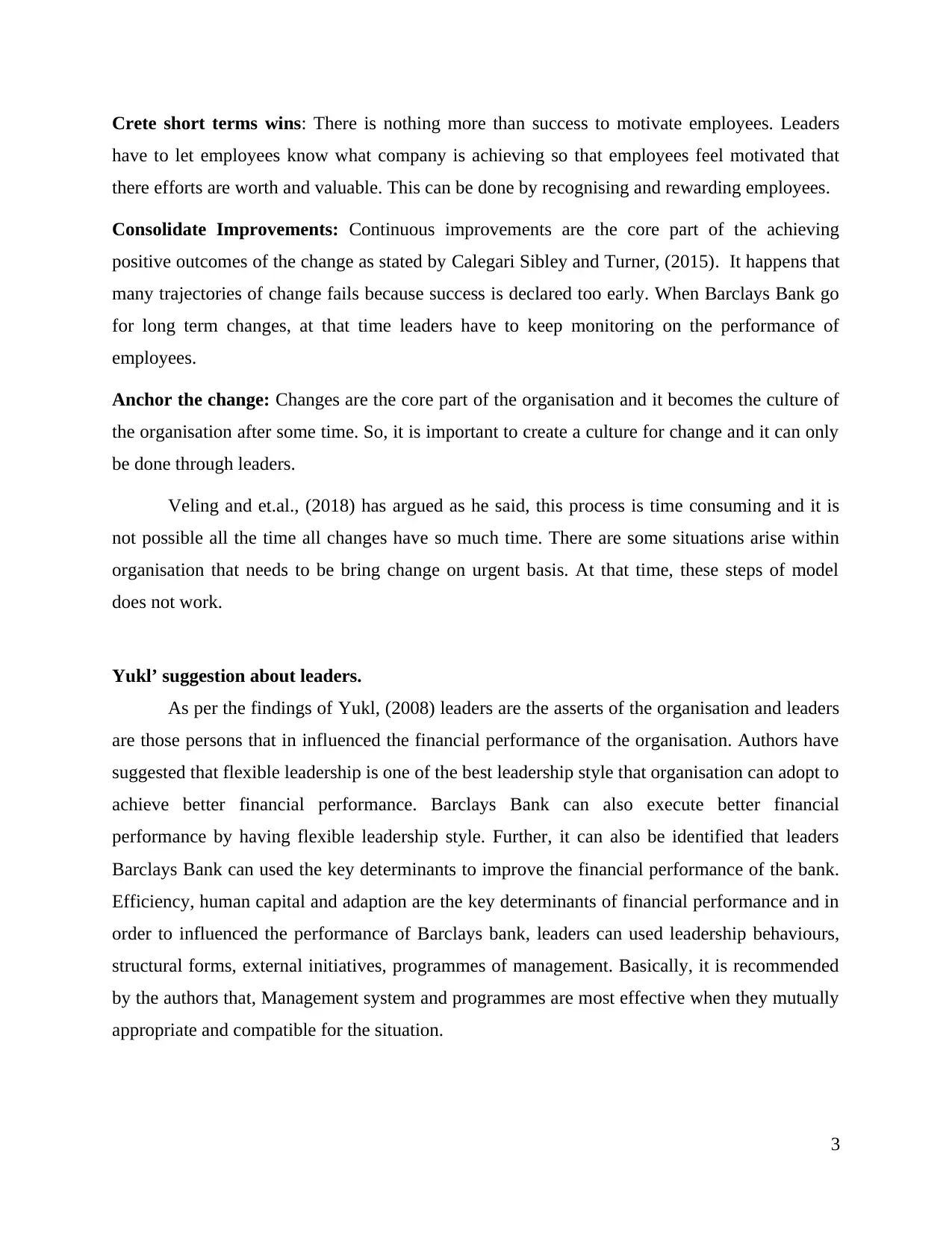
Crete short terms wins: There is nothing more than success to motivate employees. Leaders
have to let employees know what company is achieving so that employees feel motivated that
there efforts are worth and valuable. This can be done by recognising and rewarding employees.
Consolidate Improvements: Continuous improvements are the core part of the achieving
positive outcomes of the change as stated by Calegari Sibley and Turner, (2015). It happens that
many trajectories of change fails because success is declared too early. When Barclays Bank go
for long term changes, at that time leaders have to keep monitoring on the performance of
employees.
Anchor the change: Changes are the core part of the organisation and it becomes the culture of
the organisation after some time. So, it is important to create a culture for change and it can only
be done through leaders.
Veling and et.al., (2018) has argued as he said, this process is time consuming and it is
not possible all the time all changes have so much time. There are some situations arise within
organisation that needs to be bring change on urgent basis. At that time, these steps of model
does not work.
Yukl’ suggestion about leaders.
As per the findings of Yukl, (2008) leaders are the asserts of the organisation and leaders
are those persons that in influenced the financial performance of the organisation. Authors have
suggested that flexible leadership is one of the best leadership style that organisation can adopt to
achieve better financial performance. Barclays Bank can also execute better financial
performance by having flexible leadership style. Further, it can also be identified that leaders
Barclays Bank can used the key determinants to improve the financial performance of the bank.
Efficiency, human capital and adaption are the key determinants of financial performance and in
order to influenced the performance of Barclays bank, leaders can used leadership behaviours,
structural forms, external initiatives, programmes of management. Basically, it is recommended
by the authors that, Management system and programmes are most effective when they mutually
appropriate and compatible for the situation.
3
have to let employees know what company is achieving so that employees feel motivated that
there efforts are worth and valuable. This can be done by recognising and rewarding employees.
Consolidate Improvements: Continuous improvements are the core part of the achieving
positive outcomes of the change as stated by Calegari Sibley and Turner, (2015). It happens that
many trajectories of change fails because success is declared too early. When Barclays Bank go
for long term changes, at that time leaders have to keep monitoring on the performance of
employees.
Anchor the change: Changes are the core part of the organisation and it becomes the culture of
the organisation after some time. So, it is important to create a culture for change and it can only
be done through leaders.
Veling and et.al., (2018) has argued as he said, this process is time consuming and it is
not possible all the time all changes have so much time. There are some situations arise within
organisation that needs to be bring change on urgent basis. At that time, these steps of model
does not work.
Yukl’ suggestion about leaders.
As per the findings of Yukl, (2008) leaders are the asserts of the organisation and leaders
are those persons that in influenced the financial performance of the organisation. Authors have
suggested that flexible leadership is one of the best leadership style that organisation can adopt to
achieve better financial performance. Barclays Bank can also execute better financial
performance by having flexible leadership style. Further, it can also be identified that leaders
Barclays Bank can used the key determinants to improve the financial performance of the bank.
Efficiency, human capital and adaption are the key determinants of financial performance and in
order to influenced the performance of Barclays bank, leaders can used leadership behaviours,
structural forms, external initiatives, programmes of management. Basically, it is recommended
by the authors that, Management system and programmes are most effective when they mutually
appropriate and compatible for the situation.
3
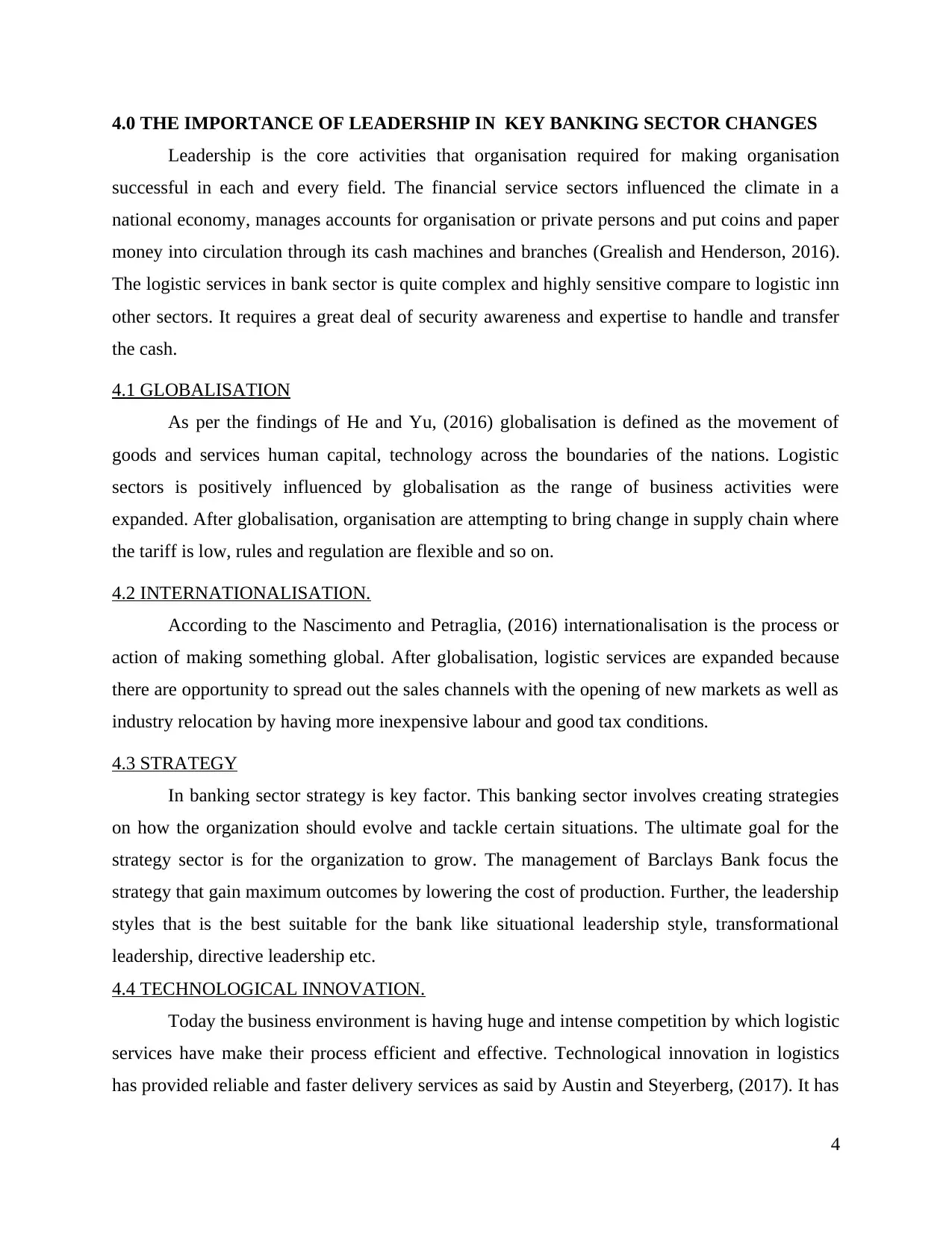
4.0 THE IMPORTANCE OF LEADERSHIP IN KEY BANKING SECTOR CHANGES
Leadership is the core activities that organisation required for making organisation
successful in each and every field. The financial service sectors influenced the climate in a
national economy, manages accounts for organisation or private persons and put coins and paper
money into circulation through its cash machines and branches (Grealish and Henderson, 2016).
The logistic services in bank sector is quite complex and highly sensitive compare to logistic inn
other sectors. It requires a great deal of security awareness and expertise to handle and transfer
the cash.
4.1 GLOBALISATION
As per the findings of He and Yu, (2016) globalisation is defined as the movement of
goods and services human capital, technology across the boundaries of the nations. Logistic
sectors is positively influenced by globalisation as the range of business activities were
expanded. After globalisation, organisation are attempting to bring change in supply chain where
the tariff is low, rules and regulation are flexible and so on.
4.2 INTERNATIONALISATION.
According to the Nascimento and Petraglia, (2016) internationalisation is the process or
action of making something global. After globalisation, logistic services are expanded because
there are opportunity to spread out the sales channels with the opening of new markets as well as
industry relocation by having more inexpensive labour and good tax conditions.
4.3 STRATEGY
In banking sector strategy is key factor. This banking sector involves creating strategies
on how the organization should evolve and tackle certain situations. The ultimate goal for the
strategy sector is for the organization to grow. The management of Barclays Bank focus the
strategy that gain maximum outcomes by lowering the cost of production. Further, the leadership
styles that is the best suitable for the bank like situational leadership style, transformational
leadership, directive leadership etc.
4.4 TECHNOLOGICAL INNOVATION.
Today the business environment is having huge and intense competition by which logistic
services have make their process efficient and effective. Technological innovation in logistics
has provided reliable and faster delivery services as said by Austin and Steyerberg, (2017). It has
4
Leadership is the core activities that organisation required for making organisation
successful in each and every field. The financial service sectors influenced the climate in a
national economy, manages accounts for organisation or private persons and put coins and paper
money into circulation through its cash machines and branches (Grealish and Henderson, 2016).
The logistic services in bank sector is quite complex and highly sensitive compare to logistic inn
other sectors. It requires a great deal of security awareness and expertise to handle and transfer
the cash.
4.1 GLOBALISATION
As per the findings of He and Yu, (2016) globalisation is defined as the movement of
goods and services human capital, technology across the boundaries of the nations. Logistic
sectors is positively influenced by globalisation as the range of business activities were
expanded. After globalisation, organisation are attempting to bring change in supply chain where
the tariff is low, rules and regulation are flexible and so on.
4.2 INTERNATIONALISATION.
According to the Nascimento and Petraglia, (2016) internationalisation is the process or
action of making something global. After globalisation, logistic services are expanded because
there are opportunity to spread out the sales channels with the opening of new markets as well as
industry relocation by having more inexpensive labour and good tax conditions.
4.3 STRATEGY
In banking sector strategy is key factor. This banking sector involves creating strategies
on how the organization should evolve and tackle certain situations. The ultimate goal for the
strategy sector is for the organization to grow. The management of Barclays Bank focus the
strategy that gain maximum outcomes by lowering the cost of production. Further, the leadership
styles that is the best suitable for the bank like situational leadership style, transformational
leadership, directive leadership etc.
4.4 TECHNOLOGICAL INNOVATION.
Today the business environment is having huge and intense competition by which logistic
services have make their process efficient and effective. Technological innovation in logistics
has provided reliable and faster delivery services as said by Austin and Steyerberg, (2017). It has
4
⊘ This is a preview!⊘
Do you want full access?
Subscribe today to unlock all pages.

Trusted by 1+ million students worldwide
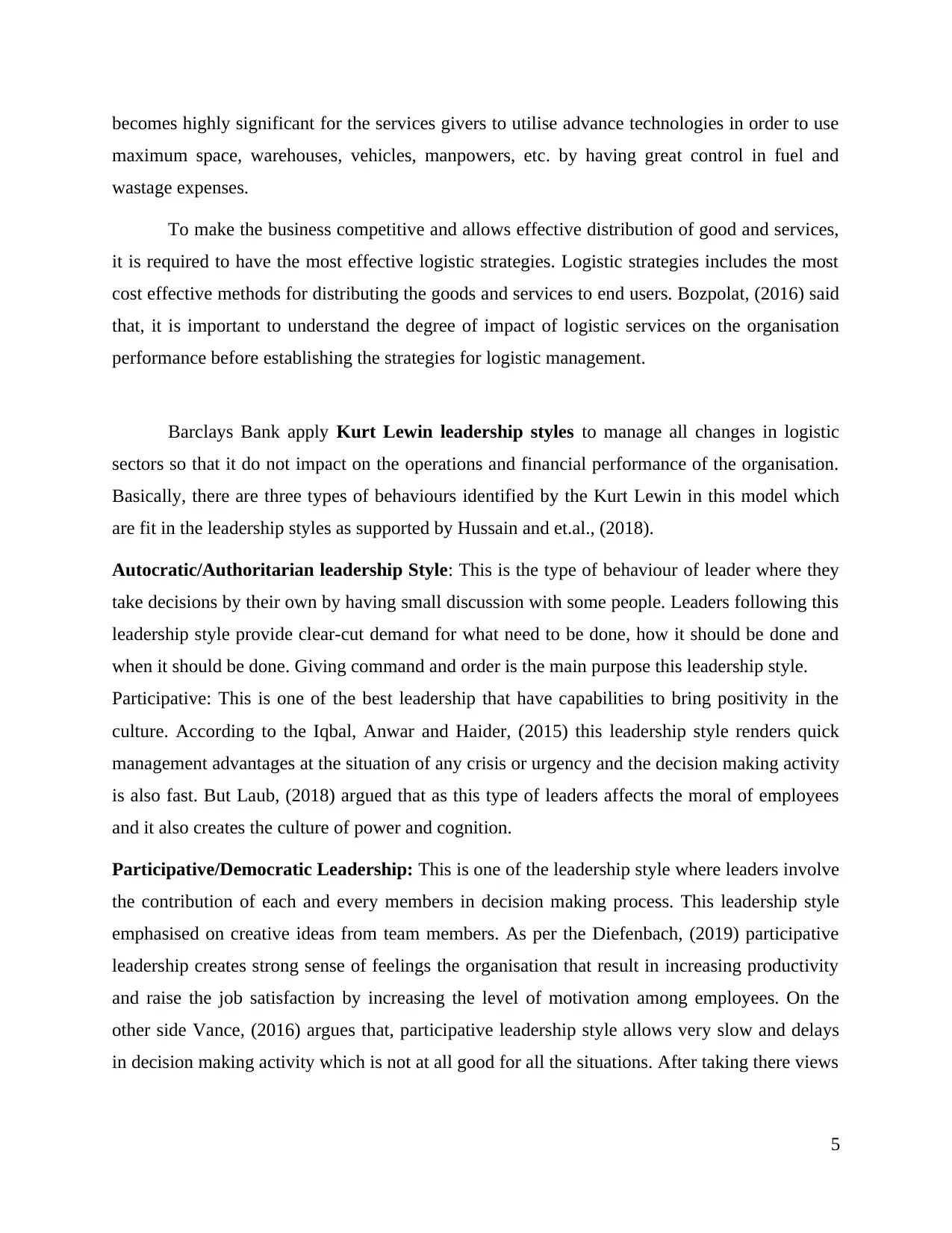
becomes highly significant for the services givers to utilise advance technologies in order to use
maximum space, warehouses, vehicles, manpowers, etc. by having great control in fuel and
wastage expenses.
To make the business competitive and allows effective distribution of good and services,
it is required to have the most effective logistic strategies. Logistic strategies includes the most
cost effective methods for distributing the goods and services to end users. Bozpolat, (2016) said
that, it is important to understand the degree of impact of logistic services on the organisation
performance before establishing the strategies for logistic management.
Barclays Bank apply Kurt Lewin leadership styles to manage all changes in logistic
sectors so that it do not impact on the operations and financial performance of the organisation.
Basically, there are three types of behaviours identified by the Kurt Lewin in this model which
are fit in the leadership styles as supported by Hussain and et.al., (2018).
Autocratic/Authoritarian leadership Style: This is the type of behaviour of leader where they
take decisions by their own by having small discussion with some people. Leaders following this
leadership style provide clear-cut demand for what need to be done, how it should be done and
when it should be done. Giving command and order is the main purpose this leadership style.
Participative: This is one of the best leadership that have capabilities to bring positivity in the
culture. According to the Iqbal, Anwar and Haider, (2015) this leadership style renders quick
management advantages at the situation of any crisis or urgency and the decision making activity
is also fast. But Laub, (2018) argued that as this type of leaders affects the moral of employees
and it also creates the culture of power and cognition.
Participative/Democratic Leadership: This is one of the leadership style where leaders involve
the contribution of each and every members in decision making process. This leadership style
emphasised on creative ideas from team members. As per the Diefenbach, (2019) participative
leadership creates strong sense of feelings the organisation that result in increasing productivity
and raise the job satisfaction by increasing the level of motivation among employees. On the
other side Vance, (2016) argues that, participative leadership style allows very slow and delays
in decision making activity which is not at all good for all the situations. After taking there views
5
maximum space, warehouses, vehicles, manpowers, etc. by having great control in fuel and
wastage expenses.
To make the business competitive and allows effective distribution of good and services,
it is required to have the most effective logistic strategies. Logistic strategies includes the most
cost effective methods for distributing the goods and services to end users. Bozpolat, (2016) said
that, it is important to understand the degree of impact of logistic services on the organisation
performance before establishing the strategies for logistic management.
Barclays Bank apply Kurt Lewin leadership styles to manage all changes in logistic
sectors so that it do not impact on the operations and financial performance of the organisation.
Basically, there are three types of behaviours identified by the Kurt Lewin in this model which
are fit in the leadership styles as supported by Hussain and et.al., (2018).
Autocratic/Authoritarian leadership Style: This is the type of behaviour of leader where they
take decisions by their own by having small discussion with some people. Leaders following this
leadership style provide clear-cut demand for what need to be done, how it should be done and
when it should be done. Giving command and order is the main purpose this leadership style.
Participative: This is one of the best leadership that have capabilities to bring positivity in the
culture. According to the Iqbal, Anwar and Haider, (2015) this leadership style renders quick
management advantages at the situation of any crisis or urgency and the decision making activity
is also fast. But Laub, (2018) argued that as this type of leaders affects the moral of employees
and it also creates the culture of power and cognition.
Participative/Democratic Leadership: This is one of the leadership style where leaders involve
the contribution of each and every members in decision making process. This leadership style
emphasised on creative ideas from team members. As per the Diefenbach, (2019) participative
leadership creates strong sense of feelings the organisation that result in increasing productivity
and raise the job satisfaction by increasing the level of motivation among employees. On the
other side Vance, (2016) argues that, participative leadership style allows very slow and delays
in decision making activity which is not at all good for all the situations. After taking there views
5
Paraphrase This Document
Need a fresh take? Get an instant paraphrase of this document with our AI Paraphraser
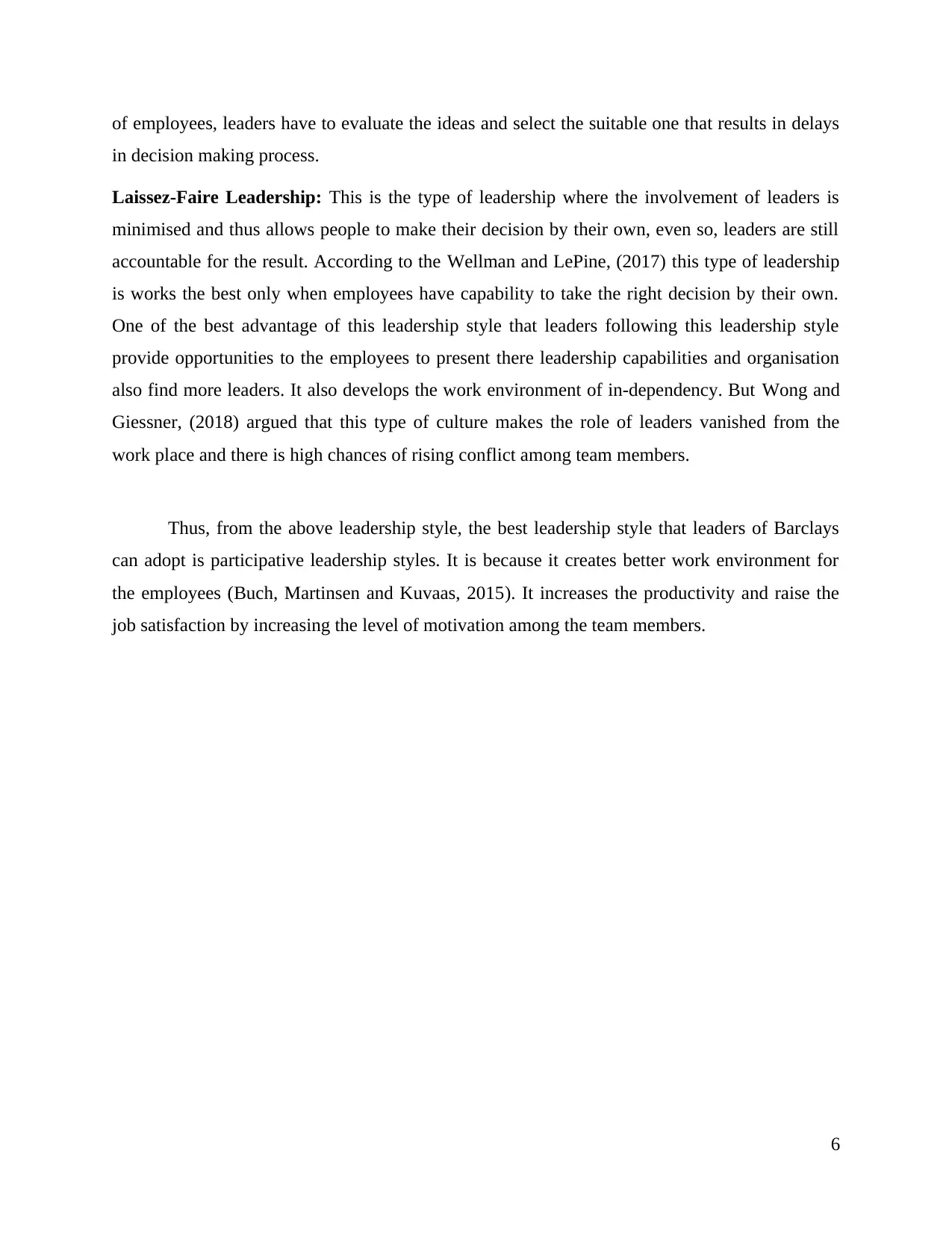
of employees, leaders have to evaluate the ideas and select the suitable one that results in delays
in decision making process.
Laissez-Faire Leadership: This is the type of leadership where the involvement of leaders is
minimised and thus allows people to make their decision by their own, even so, leaders are still
accountable for the result. According to the Wellman and LePine, (2017) this type of leadership
is works the best only when employees have capability to take the right decision by their own.
One of the best advantage of this leadership style that leaders following this leadership style
provide opportunities to the employees to present there leadership capabilities and organisation
also find more leaders. It also develops the work environment of in-dependency. But Wong and
Giessner, (2018) argued that this type of culture makes the role of leaders vanished from the
work place and there is high chances of rising conflict among team members.
Thus, from the above leadership style, the best leadership style that leaders of Barclays
can adopt is participative leadership styles. It is because it creates better work environment for
the employees (Buch, Martinsen and Kuvaas, 2015). It increases the productivity and raise the
job satisfaction by increasing the level of motivation among the team members.
6
in decision making process.
Laissez-Faire Leadership: This is the type of leadership where the involvement of leaders is
minimised and thus allows people to make their decision by their own, even so, leaders are still
accountable for the result. According to the Wellman and LePine, (2017) this type of leadership
is works the best only when employees have capability to take the right decision by their own.
One of the best advantage of this leadership style that leaders following this leadership style
provide opportunities to the employees to present there leadership capabilities and organisation
also find more leaders. It also develops the work environment of in-dependency. But Wong and
Giessner, (2018) argued that this type of culture makes the role of leaders vanished from the
work place and there is high chances of rising conflict among team members.
Thus, from the above leadership style, the best leadership style that leaders of Barclays
can adopt is participative leadership styles. It is because it creates better work environment for
the employees (Buch, Martinsen and Kuvaas, 2015). It increases the productivity and raise the
job satisfaction by increasing the level of motivation among the team members.
6
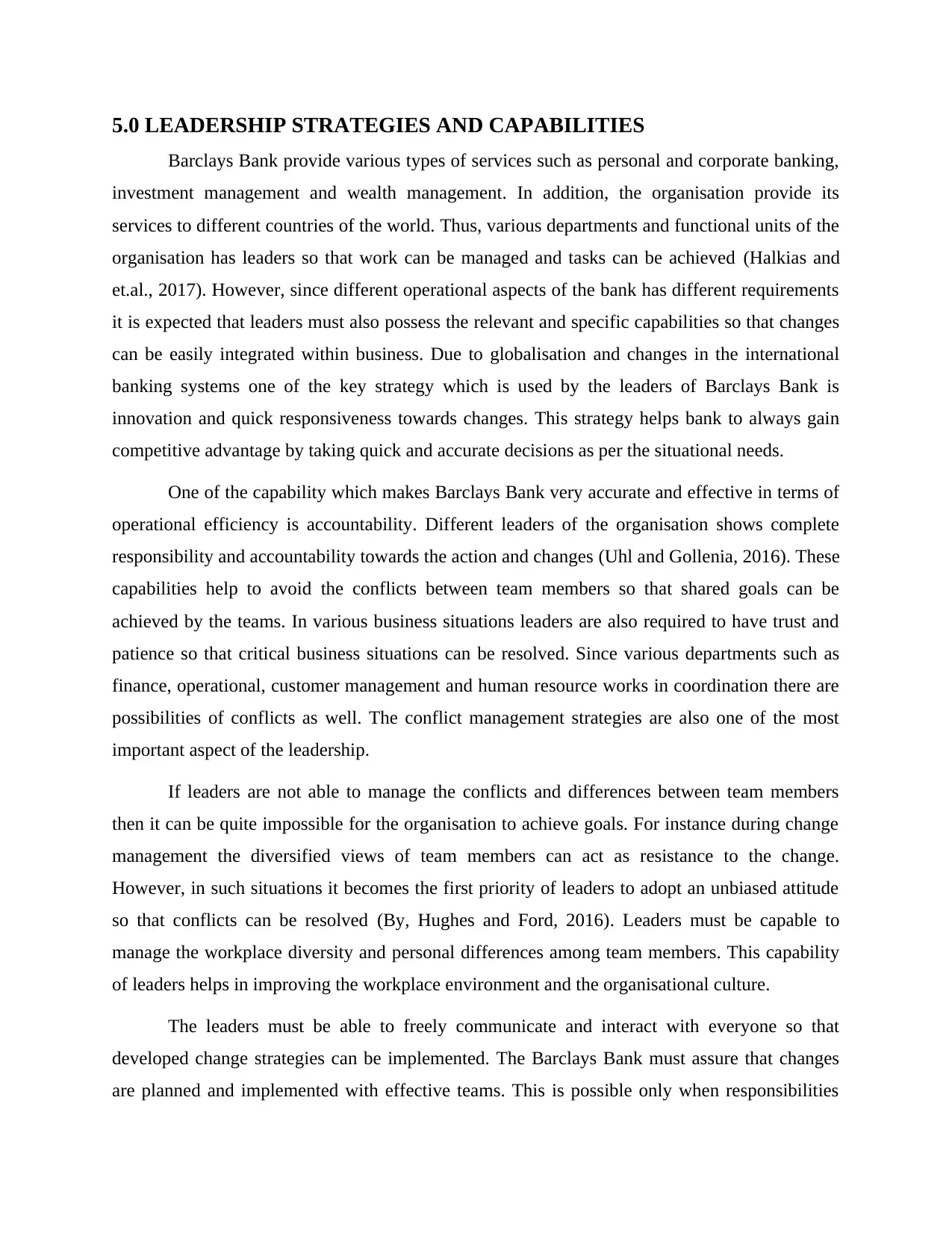
5.0 LEADERSHIP STRATEGIES AND CAPABILITIES
Barclays Bank provide various types of services such as personal and corporate banking,
investment management and wealth management. In addition, the organisation provide its
services to different countries of the world. Thus, various departments and functional units of the
organisation has leaders so that work can be managed and tasks can be achieved (Halkias and
et.al., 2017). However, since different operational aspects of the bank has different requirements
it is expected that leaders must also possess the relevant and specific capabilities so that changes
can be easily integrated within business. Due to globalisation and changes in the international
banking systems one of the key strategy which is used by the leaders of Barclays Bank is
innovation and quick responsiveness towards changes. This strategy helps bank to always gain
competitive advantage by taking quick and accurate decisions as per the situational needs.
One of the capability which makes Barclays Bank very accurate and effective in terms of
operational efficiency is accountability. Different leaders of the organisation shows complete
responsibility and accountability towards the action and changes (Uhl and Gollenia, 2016). These
capabilities help to avoid the conflicts between team members so that shared goals can be
achieved by the teams. In various business situations leaders are also required to have trust and
patience so that critical business situations can be resolved. Since various departments such as
finance, operational, customer management and human resource works in coordination there are
possibilities of conflicts as well. The conflict management strategies are also one of the most
important aspect of the leadership.
If leaders are not able to manage the conflicts and differences between team members
then it can be quite impossible for the organisation to achieve goals. For instance during change
management the diversified views of team members can act as resistance to the change.
However, in such situations it becomes the first priority of leaders to adopt an unbiased attitude
so that conflicts can be resolved (By, Hughes and Ford, 2016). Leaders must be capable to
manage the workplace diversity and personal differences among team members. This capability
of leaders helps in improving the workplace environment and the organisational culture.
The leaders must be able to freely communicate and interact with everyone so that
developed change strategies can be implemented. The Barclays Bank must assure that changes
are planned and implemented with effective teams. This is possible only when responsibilities
Barclays Bank provide various types of services such as personal and corporate banking,
investment management and wealth management. In addition, the organisation provide its
services to different countries of the world. Thus, various departments and functional units of the
organisation has leaders so that work can be managed and tasks can be achieved (Halkias and
et.al., 2017). However, since different operational aspects of the bank has different requirements
it is expected that leaders must also possess the relevant and specific capabilities so that changes
can be easily integrated within business. Due to globalisation and changes in the international
banking systems one of the key strategy which is used by the leaders of Barclays Bank is
innovation and quick responsiveness towards changes. This strategy helps bank to always gain
competitive advantage by taking quick and accurate decisions as per the situational needs.
One of the capability which makes Barclays Bank very accurate and effective in terms of
operational efficiency is accountability. Different leaders of the organisation shows complete
responsibility and accountability towards the action and changes (Uhl and Gollenia, 2016). These
capabilities help to avoid the conflicts between team members so that shared goals can be
achieved by the teams. In various business situations leaders are also required to have trust and
patience so that critical business situations can be resolved. Since various departments such as
finance, operational, customer management and human resource works in coordination there are
possibilities of conflicts as well. The conflict management strategies are also one of the most
important aspect of the leadership.
If leaders are not able to manage the conflicts and differences between team members
then it can be quite impossible for the organisation to achieve goals. For instance during change
management the diversified views of team members can act as resistance to the change.
However, in such situations it becomes the first priority of leaders to adopt an unbiased attitude
so that conflicts can be resolved (By, Hughes and Ford, 2016). Leaders must be capable to
manage the workplace diversity and personal differences among team members. This capability
of leaders helps in improving the workplace environment and the organisational culture.
The leaders must be able to freely communicate and interact with everyone so that
developed change strategies can be implemented. The Barclays Bank must assure that changes
are planned and implemented with effective teams. This is possible only when responsibilities
⊘ This is a preview!⊘
Do you want full access?
Subscribe today to unlock all pages.

Trusted by 1+ million students worldwide

are given to desirable and efficient employees (Holten and Brenner, 2015). The leaders of
Barclays Bank are highly responsible and have capability to assess the strengths and weakness of
other individuals. This capability of leaders assist them in allocating suitable job roles to them so
that each individual in the bank can deliver their optimum output.
2
Barclays Bank are highly responsible and have capability to assess the strengths and weakness of
other individuals. This capability of leaders assist them in allocating suitable job roles to them so
that each individual in the bank can deliver their optimum output.
2
Paraphrase This Document
Need a fresh take? Get an instant paraphrase of this document with our AI Paraphraser
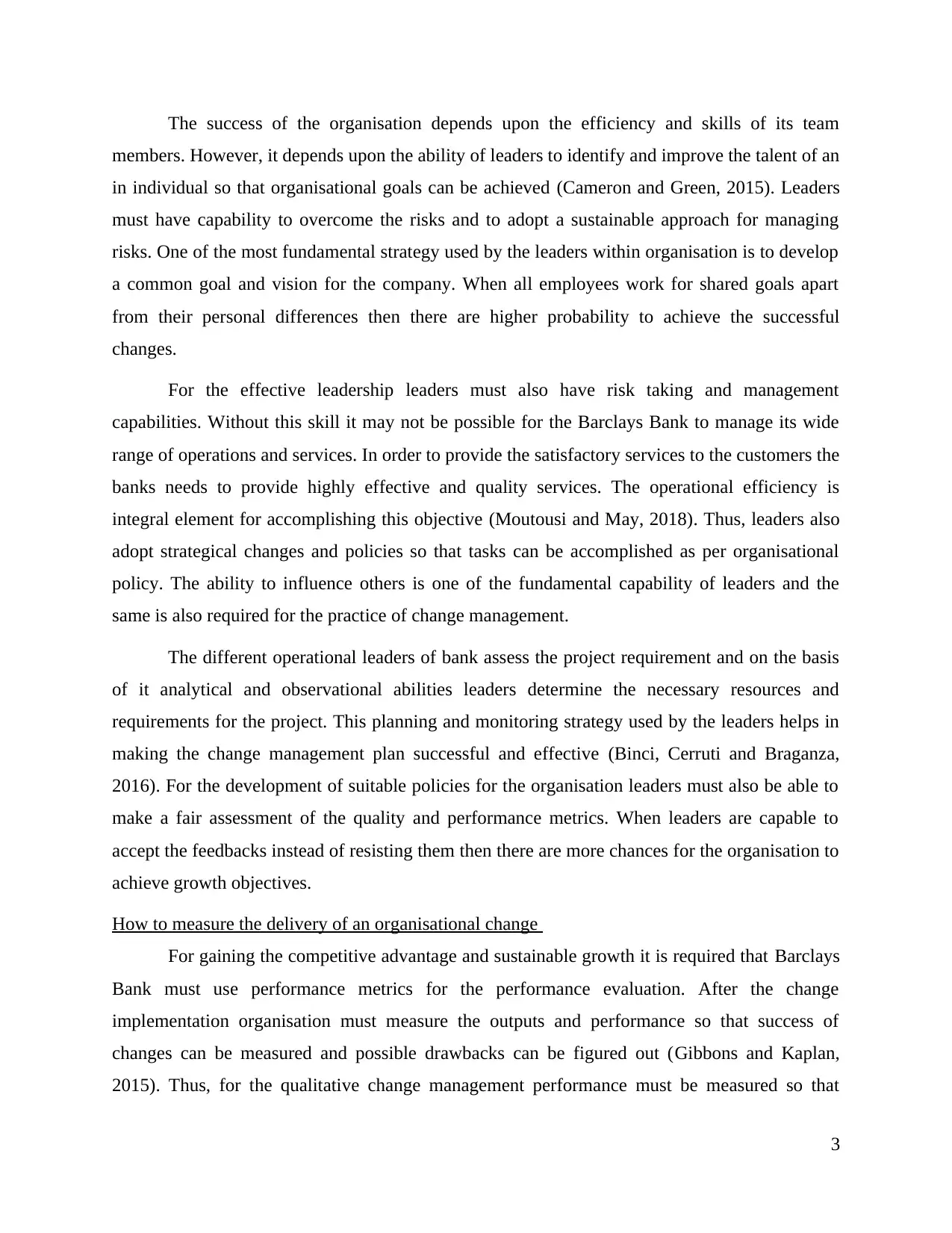
The success of the organisation depends upon the efficiency and skills of its team
members. However, it depends upon the ability of leaders to identify and improve the talent of an
in individual so that organisational goals can be achieved (Cameron and Green, 2015). Leaders
must have capability to overcome the risks and to adopt a sustainable approach for managing
risks. One of the most fundamental strategy used by the leaders within organisation is to develop
a common goal and vision for the company. When all employees work for shared goals apart
from their personal differences then there are higher probability to achieve the successful
changes.
For the effective leadership leaders must also have risk taking and management
capabilities. Without this skill it may not be possible for the Barclays Bank to manage its wide
range of operations and services. In order to provide the satisfactory services to the customers the
banks needs to provide highly effective and quality services. The operational efficiency is
integral element for accomplishing this objective (Moutousi and May, 2018). Thus, leaders also
adopt strategical changes and policies so that tasks can be accomplished as per organisational
policy. The ability to influence others is one of the fundamental capability of leaders and the
same is also required for the practice of change management.
The different operational leaders of bank assess the project requirement and on the basis
of it analytical and observational abilities leaders determine the necessary resources and
requirements for the project. This planning and monitoring strategy used by the leaders helps in
making the change management plan successful and effective (Binci, Cerruti and Braganza,
2016). For the development of suitable policies for the organisation leaders must also be able to
make a fair assessment of the quality and performance metrics. When leaders are capable to
accept the feedbacks instead of resisting them then there are more chances for the organisation to
achieve growth objectives.
How to measure the delivery of an organisational change
For gaining the competitive advantage and sustainable growth it is required that Barclays
Bank must use performance metrics for the performance evaluation. After the change
implementation organisation must measure the outputs and performance so that success of
changes can be measured and possible drawbacks can be figured out (Gibbons and Kaplan,
2015). Thus, for the qualitative change management performance must be measured so that
3
members. However, it depends upon the ability of leaders to identify and improve the talent of an
in individual so that organisational goals can be achieved (Cameron and Green, 2015). Leaders
must have capability to overcome the risks and to adopt a sustainable approach for managing
risks. One of the most fundamental strategy used by the leaders within organisation is to develop
a common goal and vision for the company. When all employees work for shared goals apart
from their personal differences then there are higher probability to achieve the successful
changes.
For the effective leadership leaders must also have risk taking and management
capabilities. Without this skill it may not be possible for the Barclays Bank to manage its wide
range of operations and services. In order to provide the satisfactory services to the customers the
banks needs to provide highly effective and quality services. The operational efficiency is
integral element for accomplishing this objective (Moutousi and May, 2018). Thus, leaders also
adopt strategical changes and policies so that tasks can be accomplished as per organisational
policy. The ability to influence others is one of the fundamental capability of leaders and the
same is also required for the practice of change management.
The different operational leaders of bank assess the project requirement and on the basis
of it analytical and observational abilities leaders determine the necessary resources and
requirements for the project. This planning and monitoring strategy used by the leaders helps in
making the change management plan successful and effective (Binci, Cerruti and Braganza,
2016). For the development of suitable policies for the organisation leaders must also be able to
make a fair assessment of the quality and performance metrics. When leaders are capable to
accept the feedbacks instead of resisting them then there are more chances for the organisation to
achieve growth objectives.
How to measure the delivery of an organisational change
For gaining the competitive advantage and sustainable growth it is required that Barclays
Bank must use performance metrics for the performance evaluation. After the change
implementation organisation must measure the outputs and performance so that success of
changes can be measured and possible drawbacks can be figured out (Gibbons and Kaplan,
2015). Thus, for the qualitative change management performance must be measured so that
3
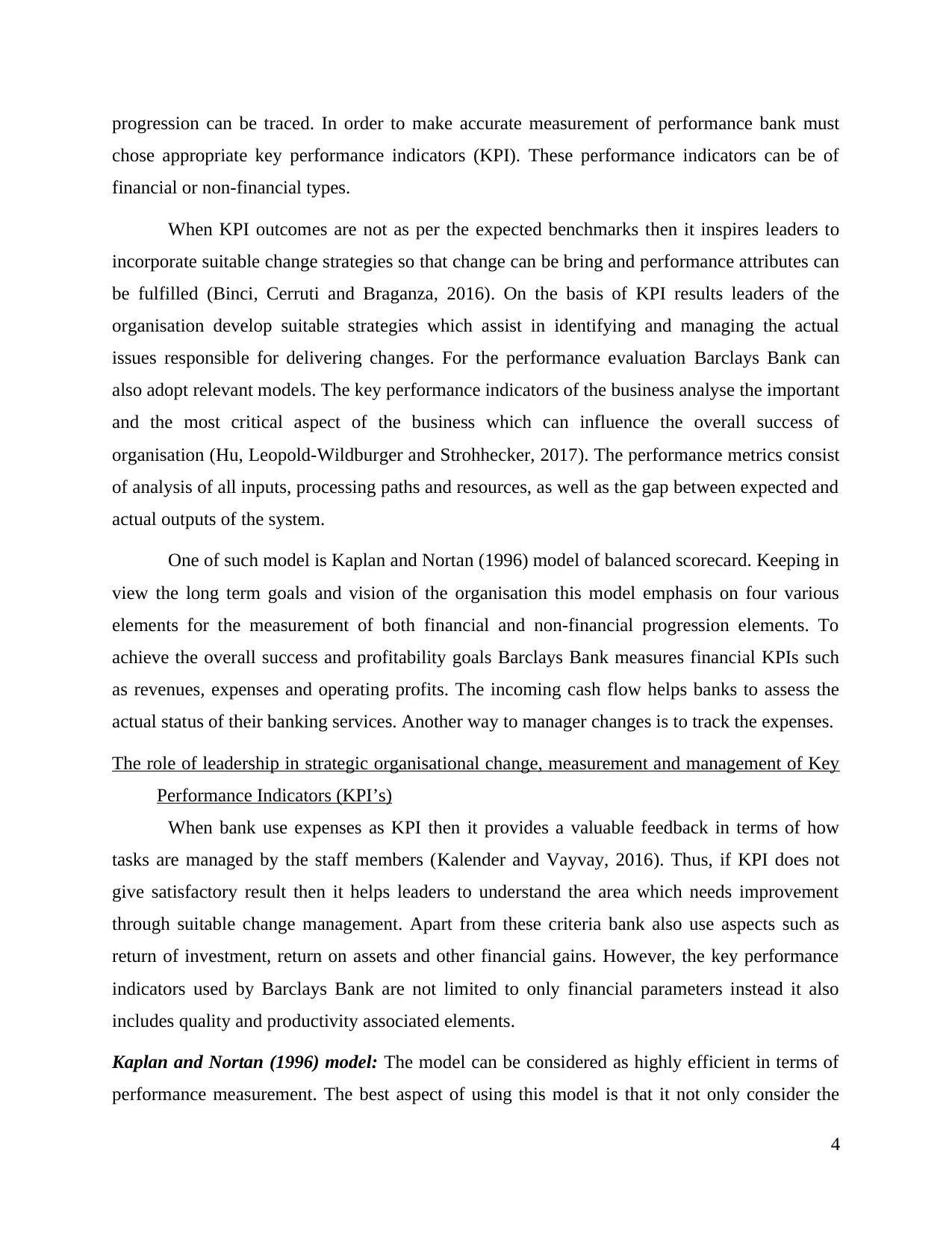
progression can be traced. In order to make accurate measurement of performance bank must
chose appropriate key performance indicators (KPI). These performance indicators can be of
financial or non-financial types.
When KPI outcomes are not as per the expected benchmarks then it inspires leaders to
incorporate suitable change strategies so that change can be bring and performance attributes can
be fulfilled (Binci, Cerruti and Braganza, 2016). On the basis of KPI results leaders of the
organisation develop suitable strategies which assist in identifying and managing the actual
issues responsible for delivering changes. For the performance evaluation Barclays Bank can
also adopt relevant models. The key performance indicators of the business analyse the important
and the most critical aspect of the business which can influence the overall success of
organisation (Hu, Leopold-Wildburger and Strohhecker, 2017). The performance metrics consist
of analysis of all inputs, processing paths and resources, as well as the gap between expected and
actual outputs of the system.
One of such model is Kaplan and Nortan (1996) model of balanced scorecard. Keeping in
view the long term goals and vision of the organisation this model emphasis on four various
elements for the measurement of both financial and non-financial progression elements. To
achieve the overall success and profitability goals Barclays Bank measures financial KPIs such
as revenues, expenses and operating profits. The incoming cash flow helps banks to assess the
actual status of their banking services. Another way to manager changes is to track the expenses.
The role of leadership in strategic organisational change, measurement and management of Key
Performance Indicators (KPI’s)
When bank use expenses as KPI then it provides a valuable feedback in terms of how
tasks are managed by the staff members (Kalender and Vayvay, 2016). Thus, if KPI does not
give satisfactory result then it helps leaders to understand the area which needs improvement
through suitable change management. Apart from these criteria bank also use aspects such as
return of investment, return on assets and other financial gains. However, the key performance
indicators used by Barclays Bank are not limited to only financial parameters instead it also
includes quality and productivity associated elements.
Kaplan and Nortan (1996) model: The model can be considered as highly efficient in terms of
performance measurement. The best aspect of using this model is that it not only consider the
4
chose appropriate key performance indicators (KPI). These performance indicators can be of
financial or non-financial types.
When KPI outcomes are not as per the expected benchmarks then it inspires leaders to
incorporate suitable change strategies so that change can be bring and performance attributes can
be fulfilled (Binci, Cerruti and Braganza, 2016). On the basis of KPI results leaders of the
organisation develop suitable strategies which assist in identifying and managing the actual
issues responsible for delivering changes. For the performance evaluation Barclays Bank can
also adopt relevant models. The key performance indicators of the business analyse the important
and the most critical aspect of the business which can influence the overall success of
organisation (Hu, Leopold-Wildburger and Strohhecker, 2017). The performance metrics consist
of analysis of all inputs, processing paths and resources, as well as the gap between expected and
actual outputs of the system.
One of such model is Kaplan and Nortan (1996) model of balanced scorecard. Keeping in
view the long term goals and vision of the organisation this model emphasis on four various
elements for the measurement of both financial and non-financial progression elements. To
achieve the overall success and profitability goals Barclays Bank measures financial KPIs such
as revenues, expenses and operating profits. The incoming cash flow helps banks to assess the
actual status of their banking services. Another way to manager changes is to track the expenses.
The role of leadership in strategic organisational change, measurement and management of Key
Performance Indicators (KPI’s)
When bank use expenses as KPI then it provides a valuable feedback in terms of how
tasks are managed by the staff members (Kalender and Vayvay, 2016). Thus, if KPI does not
give satisfactory result then it helps leaders to understand the area which needs improvement
through suitable change management. Apart from these criteria bank also use aspects such as
return of investment, return on assets and other financial gains. However, the key performance
indicators used by Barclays Bank are not limited to only financial parameters instead it also
includes quality and productivity associated elements.
Kaplan and Nortan (1996) model: The model can be considered as highly efficient in terms of
performance measurement. The best aspect of using this model is that it not only consider the
4
⊘ This is a preview!⊘
Do you want full access?
Subscribe today to unlock all pages.

Trusted by 1+ million students worldwide
1 out of 19
Related Documents
Your All-in-One AI-Powered Toolkit for Academic Success.
+13062052269
info@desklib.com
Available 24*7 on WhatsApp / Email
![[object Object]](/_next/static/media/star-bottom.7253800d.svg)
Unlock your academic potential
Copyright © 2020–2025 A2Z Services. All Rights Reserved. Developed and managed by ZUCOL.





